
Marquess of Anglesey is a title in the Peerage of the United Kingdom. It was created in 1815 for Henry Paget, 2nd Earl of Uxbridge, a hero of the Battle of Waterloo, second in command to the Duke of Wellington. The Marquess holds the subsidiary titles of Earl of Uxbridge, in the County of Middlesex, in the Peerage of Great Britain (1784), Baron Paget, de Beaudesert, in the Peerage of England (1553), and is also an Irish Baronet, of Plas Newydd in the County of Anglesey and of Mount Bagenall in the County of Louth.

Viscount Falmouth is a title that has been created twice, first in the Peerage of England, and then in the Peerage of Great Britain. The first creation came in the Peerage of England in 1674 for George FitzRoy, illegitimate son of King Charles II by Barbara Villiers. He was created Earl of Northumberland at the same time and in 1683 he was made Duke of Northumberland. However, he left no heirs, so the titles became extinct at his death in 1716.
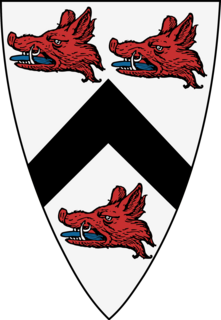
Lord Elphinstone is a title in the Peerage of Scotland created by King James IV in 1510.

Earl of Powis (Powys) is a title that has been created three times. The first creation came in the Peerage of England in 1674 in favour of William Herbert, 3rd Baron Powis, a descendant of William Herbert, 1st Earl of Pembroke. In 1687, he was further honoured when he was made Marquess of Powis.
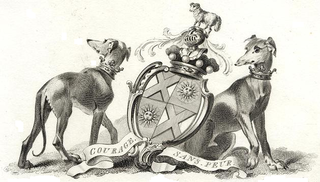
Viscount Gage, of Castle Island in the County of Kerry of the Kingdom of Ireland, is a title in the Peerage of Ireland. It was created in 1720 for Thomas Gage, along with the subsidiary title of Baron Gage, of Castlebar in the County of Mayo, also in the Peerage of Ireland. In 1744 he also succeeded his cousin as eighth Baronet, of Firle Place. The titles remain united. The Gage family descends from John Gage, who was created a baronet, of Firle Place in the County of Sussex, in the Baronetage of England on 26 March 1622. His great-grandson, the seventh Baronet, represented Seaford in Parliament. He was succeeded by his first cousin, Thomas Gage, 1st Viscount Gage, the eighth Baronet. He sat as a Member of Parliament for Minehead and Tewkesbury and also served as Governor of Barbados. In 1720, 24 years before succeeding in the baronetcy, he was raised to the Peerage of Ireland as Baron Gage and Viscount Gage. His second son was the military commander the Hon. Thomas Gage.
Viscount Hampden is a title that has been created twice, once in the Peerage of Great Britain and once in the Peerage of the United Kingdom. The first creation came in the Peerage of Great Britain when the diplomat and politician Robert Hampden, 4th Baron Trevor, was created Viscount Hampden, of Great and Little Hampden in the County of Bedford on 14 June 1776. The title of Baron Trevor, of Bromham, had been created in the Peerage of Great Britain in 1712 for his father, the lawyer Sir Thomas Trevor. Both titles became extinct in 1824 on the death of the first Viscount's second son, the third Viscount.
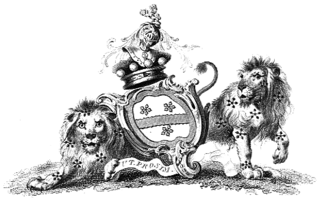
Baron Foley is a title that has been created twice in the Peerage of Great Britain, both times for members of the same family.

Baron Lilford, of Lilford in the County of Northampton, is a title in the Peerage of Great Britain. It was created in 1797 for Thomas Powys, who had previously represented Northamptonshire in the House of Commons. His grandson, the third Baron, served as a Lord-in-waiting from 1837 to 1841 in the Whig administration of Lord Melbourne. He was succeeded by his son, the fourth Baron, an ornithologist.

Baron Langford, of Summerhill in the County of Meath, is a title in the Peerage of Ireland. It was created on 1 July 1800 for Clotworthy Rowley, who had earlier represented Trim and County Meath in the Irish House of Commons. Born Clotworthy Taylor, he was the fourth son of Thomas Taylor, 1st Earl of Bective and Jane Rowley, daughter of Hercules Langford Rowley and his wife Elizabeth Rowley, 1st Viscountess Langford. The viscountcy of Langford became extinct in 1796 on the death of Hercules Rowley, 2nd Viscount Langford. Clotworthy Taylor succeeded to the Rowley estates and assumed by Royal licence the surname of Rowley in lieu of Taylor. Four years later the Langford title was revived when he was raised to the Peerage of Ireland as Baron Langford.

Baron Hotham, of South Dalton in the County of York, is a title in the Peerage of Ireland. It was created in 1797 for the naval commander Admiral William Hotham, with remainder to the heirs male of his father. Hotham was the third son of Sir Beaumont Hotham, 7th Baronet, of Scorborough, and in 1811 he also succeeded his nephew as eleventh Baronet. Lord Hotham never married and on his death in 1813 he was succeeded in both titles by his younger brother Beaumont, the second Baron and twelfth Baronet. He had previously represented Wigan in the House of Commons.

Baron Harris, of Seringapatam and Mysore in the East Indies and of Belmont in the County of Kent, is a title in the Peerage of the United Kingdom.

Baron Ellenborough, of Ellenborough in the County of Cumberland, is a title in the Peerage of the United Kingdom. It was created on 19 April 1802 for the lawyer, judge and politician Sir Edward Law, Lord Chief Justice of the King's Bench from 1802 to 1818. His son, the second Baron, notably served as Governor-General of India. On 22 October 1844 the second Baron was created Viscount Southam, of Southam in the County of Gloucester, and Earl of Ellenborough, in the County of Cumberland. These titles were also in the Peerage of the United Kingdom. His only son predeceased him and on his death in 1871 the viscountcy and earldom became extinct.
Baron Hothfield, of Hothfield in the County of Kent, is a title in the Peerage of the United Kingdom. It was created in 1881 for Sir Henry Tufton, 2nd Baronet, who was appointed Lord Lieutenant of Westmorland the same year and who also served briefly as a government whip in the Liberal administration of 1886. His eldest son, the second Baron, notably served as Mayor of Appleby, Westmorland. On the death of his son, the third Baron, in 1961, this line of the family failed. The late Baron was succeeded by his first cousin, the fourth Baron. He was the only son of the Hon. Sackville Philip Tufton, second son of the first Baron. On his death in 1986 this line of the family also failed and the titles passed to his first cousin, the fifth Baron. He was the eldest son of the Hon. Charles Henry Tufton, third son of the first Baron. As of 2017 the titles are held by his son, the sixth Baron, who succeeded in 1991.

Baron Glenconner, of The Glen in the County of Peebles, is a title in the Peerage of the United Kingdom. It was created in 1911 for Sir Edward Tennant, 2nd Baronet, who had earlier represented Salisbury in the House of Commons as a Liberal and also served as Lord Lieutenant of Peeblesshire. Lord Glenconner was succeeded by his second son, the second baron. The latter was succeeded in 1983 by his eldest son, the third baron, who bought the island of Mustique. As of 2014, the titles are held by the third baron's grandson, the fourth baron, who became the next-to-youngest peer in the realm when he succeeded in August 2010.

Baron Abinger, of Abinger in the County of Surrey and of the City of Norwich, is a title in the Peerage of the United Kingdom. It was created on 12 January 1835 for the prominent lawyer and politician Sir James Scarlett, the Lord Chief Baron of the Exchequer. Lord Abinger was succeeded by his eldest son, the second Baron. He represented Norwich and Horsham in the House of Commons. He was succeeded by his son, the third Baron. He was a lieutenant-general in the army and fought in the Crimean War. On the death of his son, the fourth Baron, the line of the eldest son of the first Baron failed. The late Baron was succeeded by his second cousin, the fifth Baron. He was the grandson of Hon. Peter Campbell Scarlett, third son of the first Baron. When he died the title passed to his younger brother, the sixth Baron, and then to another brother, the seventh Baron. As of 2016 the title is held by the latter's grandson, the ninth Baron, who succeeded his father in 2002.

Baron Shaughnessy, of the City of Montreal in the Dominion of Canada and of Ashford in the County of Limerick, is a title in the Peerage of the United Kingdom. It was created in 1916 for the Milwaukee born businessman Thomas Shaughnessy, president of the Canadian Pacific Railway Company. He was succeeded by his eldest son, the second Baron, a Director of the CPR and of the Canadian Bank of Commerce. His son, the third Baron, was a businessman and was also active in the House of Lords. However, he lost his hereditary seat in parliament after the House of Lords Act 1999.
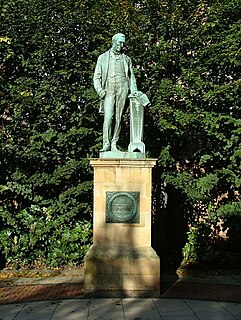
Baron Burton, of Burton-on-Trent and of Rangemore in the County of Stafford, is a title in the Peerage of the United Kingdom. It was created in 1897 for the prominent brewer, philanthropist and Liberal politician Michael Bass, 1st Baron Burton. He had already been created a baronet in 1882 and Baron Burton in 1886. However, the three titles had different remainders. The Bass family descended from William Bass, who founded the brewery business of Bass & Co in Burton upon Trent in 1777. His grandson Michael Thomas Bass transformed the company into one of the largest breweries in the United Kingdom. He also represented Derby in Parliament as a Liberal for thirty-five years and was a great benefactor to the town of Burton. However, Bass declined every honour offered to him, including a baronetcy and a peerage.
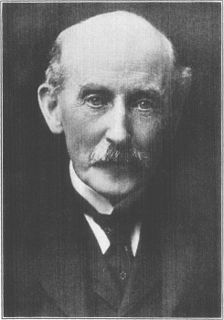
Baron Carnock, of Carnock in the County of Stirling, is a title in the Peerage of the United Kingdom. It was created in 1916 for the former Permanent Under-Secretary in the Foreign Office, Sir Arthur Nicolson, 11th Baronet.
Baron Lyveden, of Lyveden in the County of Northampton, is a title in the Peerage of the United Kingdom. It was created in 1859 for the Liberal politician Robert Vernon. Before 1859 he was known as Robert Vernon Smith. He was succeeded by his eldest son, the second Baron. When he died the title passed to his nephew, the third Baron. He was the son of Reverend the Hon. Courtenay John Vernon, third son of first Baron. On the death of his son, the fourth Baron, in 1969, this line of the family failed. The late Baron was succeeded by his second cousin, the fifth Baron. He was the grandson of the Hon. Greville Richard Vernon youngest son of the first Baron. As of 2018 the title is held by his great-grandson, the eighth Baron, who succeeded his father in 2017. Lord Lyveden lives in New Zealand.
Baron Dunleath, of Ballywalter in the County of Down, is a title in the Peerage of the United Kingdom. It was created on 29 August 1892 for the businessman and former Conservative Member of Parliament for Downpatrick, John Mulholland. The Mulholland family were involved in the cotton and linen industry in Ulster in the north of Ireland. The first Baron's son, the second Baron, represented Londonderry North in the House of Commons as a Conservative. His grandson, the fourth Baron, was a member of the Northern Ireland Assembly for the Alliance Party. He was succeeded by his first cousin, the fifth Baron, who had already succeeded his father as second Baronet of Ballyscullion. As of 2017 the titles are held by the fifth Baron's son, the sixth Baron, who succeeded in 1997.



















